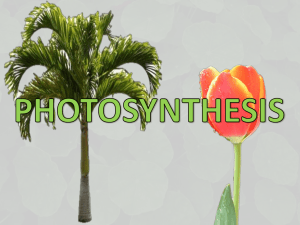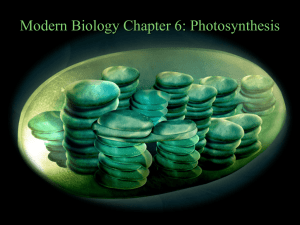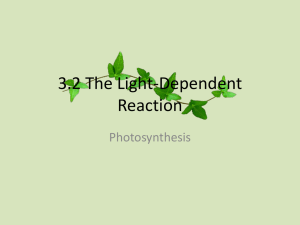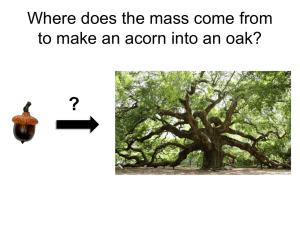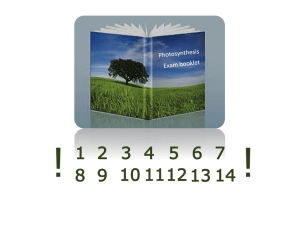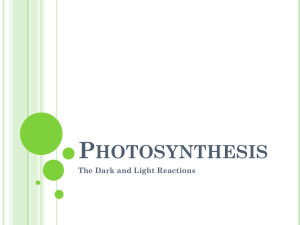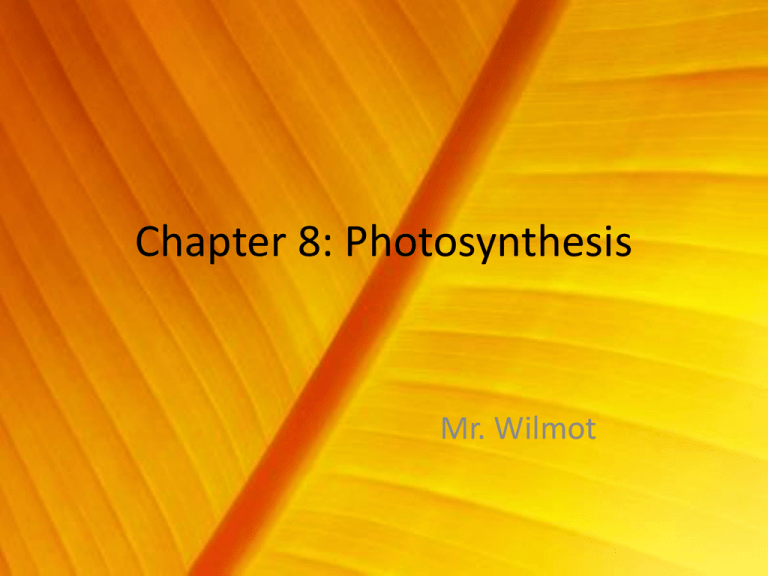
Chapter 8: Photosynthesis
Mr. Wilmot
Part I-
Photosynthetic
structures And
Overview
1. Where it takes
place
2. What structures
are involved and
what are the raw
material and
products
Photosynthesis takes place in the
mesophyll cells of the leaf
Mesophyll
Each Mesophyll
Cell contains
many
Chloroplasts
Also, CO2 comes into,
and O2 Leaves the cell
through the stoma.
Water gets to, and
Glucose leaves through
the Xylem and Phloem
Water
Glucose
CO2
O2
The Chloroplast- Contains Chlorophyll- a light
absorbing pigment
Chlorophyll
is actually
located on
the
membrane
of the
thylakoid
Granum
Thylakoid
Stroma
___________
_________ ___________
(Stack of Thylakoid)
Aqueous Place Inside
Chloroplast
Chlorophyll and Chloroplasts
1. Light- energy from the sun that travels to
earth comes in different wavelengths
a. The visible part of this spectrum appears as
different colors
Pigments- light absorbing
molecules that captures
energy from the sun
Chlorophyll- the plants principle
pigment
Include Chlorophyll A and
Chlorophyll B
There are other accessory
pigment that augment the
primary pigment allowing for
more energy to be absorbed
Include carotenoids and
xanthophylls
Chlorophyll absorbs light very well in the blue-violet
and red wavelengths
• It does not absorb green wavelengths, instead it
reflects these wavelengths
Chloroplast Anatomy
Chloroplasts- site of photosynthesis
a. Thylakoids- sac-like photosynthetic membranes
• Arranged in stacks called Grana
• Contain pigments- chlorophyll
b. Stroma- the fluid inside the chloroplast
Energy Collection
• Light is energy
• Pigments absorb light
and energy
• Light energy is
transferred directly to
electrons in the
chlorophyll molecule
• The raising of energy
levels of electrons is the
driving force of
photosynthesis
High Energy Electrons
Chemically, the high energy electrons produced
by chlorophyll require a special carrier
• Analogy: Hot potato, oven mitt = special
carrier
• Electron carriers are the so called oven mitt,
transferring these electrons from the
chlorophyll to other molecules
NADP+: is an electron
carrier
• Function- accepts
and holds two high
energy electrons
along with a
hydrogen ion (H+).
• This converts NADP+
to NADPH
• Used to help build
carbohydrates
An Overview of Photosynthesis
Light-Dependent Reactions
• Equation is a simplified
form of photosynthesis;
actually requires many
steps to get from light to
carbohydrates
• Actually involves 2 sets of
reactions
– Light depedendent
– Light independent
•
•
•
•
Light dependent- set of reactions in
photosynthesis that use energy from light to
produce ATP and NADPH
Require light and light absorbing pigments
These reactions take place within the
thylakoids of chloroplasts
Water is need for these reactions as a source
of electrons and H+
Oxygen is released as a bi-product
Confused?
Check this out…..
Light phase reactions animation
Light Independent Reactions –
a.k.a. “The Dark Side”, er Phase
a. Plants absorb CO2 from the atmosphere and
complete the process of photosynthesis
b. ATP and NADPH produced in the “light phase”
reactions are used to produce high energy
sugars…. with the addition of CO2.
Dark Phase Animation
c. No light is required
d. Reactions occur in the stroma (liquid outside
of thylakoid)
e. Reliant on the light phase for materials
f. Both light and dark phases work together to
create energy-rich carbohydrates
End of Part 1
The Process of Photosynthesis
Light-Dependent Reactions: Generating ATP and
NADPH
Summary: The light dependent reactions use energy from
sunlight to produce oxygen and convert ADP and NADP+
into the energy carriers ATP and NADPH
•
These carriers provide energy needed to build high-energy
sugars from low-energy carbon dioxide
The Light-Dependent Reaction
Takes Place on the membrane of
the Thylakoid
Light-Dependent Reactions
It happens in two parts called
photosystems:
1- Photosystem 2
2- Photosystem 1
Light-Dependent Reactions
a. Photosynthesis begins when pigments in
photosystem II absorb light, increasing their
energy level.
Photosystem II
Light-Dependent Reactions
• These high-energy electrons are passed on to
the electron transport chain.
Photosystem II
High-energy
electron
Electron
carriers
Light-Dependent Reactions
b. Enzymes on the thylakoid membrane break
water molecules into:
Photosystem II
2H2O
High-energy
electron
Electron
carriers
Copyright Pearson Prentice Hall
Light-Dependent Reactions
– hydrogen ions
– oxygen atoms
– energized electrons
Photosystem II
+
O2
2H2O
High-energy
electron
Electron
carriers
Light-Dependent Reactions
c. The energized electrons from water replace
the high-energy electrons that chlorophyll lost
to the electron transport chain.
Photosystem II
+
2H2O
High-energy
electron
O2
Light-Dependent Reactions
d. As plants remove electrons from water,
oxygen is left behind and is released into the
air.
Photosystem II
+
2H2O
High-energy
electron
O2
Light-Dependent Reactions
e. The hydrogen ions left behind when water is
broken apart are released inside the thylakoid
membrane.
Photosystem II
+
2H2O
High-energy
electron
O2
Light-Dependent Reactions
f. Energy from the electrons is used to
transport H+ ions from the stroma into the
inner thylakoid space.
Photosystem II
Inside Thylakoid
+
O2
2H2O
Outside Thylakoid
Light-Dependent Reactions
g. High-energy electrons move through the
electron transport chain from photosystem II
to photosystem I.
Photosystem II
+
O2
2H2O
Photosystem I
Light-Dependent Reactions
h. Pigments in photosystem I use energy
from light to re-energize the electrons.
+
O2
2H2O
Photosystem I
Light-Dependent Reactions
i. NADP+ then picks up these high-energy
electrons, along with H+ ions, and becomes
NADPH.
+
O2
2H2O
2 NADP+
2
2
NADPH
Light-Dependent Reactions
j. As electrons are passed from chlorophyll
to NADP+, more H+ ions are pumped across
the membrane.
+
O2
2H2O
2 NADP+
2
2
NADPH
Light-Dependent Reactions
k. Soon, the inside of the membrane fills up
with positively charged hydrogen ions, which
makes the outside of the membrane
negatively charged.
+
O2
2H2O
2 NADP+
2
2
NADPH
Light-Dependent Reactions
•The difference in charges across the
membrane provides the energy to make ATP.
+
O2
2H2O
2 NADP+
2
2
NADPH
Light-Dependent Reactions
•H+ ions cannot cross the membrane directly.
ATP synthase
+
O2
2H2O
2 NADP+
2
2
NADPH
Light-Dependent Reactions
•The cell membrane contains a protein called
ATP synthase that allows H+ ions to pass
through it.
ATP synthase
+
O2
2H2O
2 NADP+
2
2
NADPH
Light-Dependent Reactions
l. As H+ ions pass through ATP synthase, the
protein rotates.
ATP synthase
+
O2
2H2O
2 NADP+
2
2
NADPH
Light-Dependent Reactions
m. As it rotates, ATP synthase binds ADP and a
phosphate group together to produce ATP.
ATP synthase
+
O2
2H2O
2 NADP+
2
ADP
2
NADPH
Light-Dependent Reactions
•Because of this system, light-dependent
electron transport produces not only high-energy
electrons but ATP as well.
ATP synthase
+
O2
2H2O
2 NADP+
2
ADP
2
NADPH
ATP synthase
+
O2
2H2O
2 NADP+
2
ADP
2
NADPH
End of Part 2
B. The Calvin Cycle
• Also called the light independent (aka Calvin
cycle, aka “dark phase”)reactions
• ATP and NADPH formed by the lightdependent reactions contain an abundance
of chemical energy, but they are not stable
enough to store that energy for more than a
few minutes.
• 3. During the Calvin cycle plants use the
energy that ATP and NADPH contain to build
high-energy compounds that can be stored
for a long time.
The Calvin Cycle
a. Six carbon dioxide molecules enter the cycle
from the atmosphere and combine with six 5carbon molecules.
CO2 Enters the Cycle
The Calvin Cycle
b. The result is twelve 3-carbon molecules,
which are then converted into higherenergy forms.
• The energy for this conversion comes
from ATP and high-energy electrons from
NADPH.
Energy Input
12
12 ADP
12 NADPH
12 NADP+
The Calvin Cycle
c. Two of twelve 3-carbon molecules are
removed from the cycle.
Energy Input
12
12 ADP
12 NADPH
12 NADP+
• The 2 removed molecules are used to
produce sugars, lipids, amino acids and
other compounds.
12
12 ADP
12 NADPH
12 NADP+
6-Carbon sugar
produced
Sugars and other compounds
d. The 10 remaining 3-carbon molecules are
converted back into six 5-carbon
molecules, which are used to begin the
next cycle.
12
12 ADP
6 ADP
12 NADPH
6
12 NADP+
5-Carbon Molecules
Regenerated
Sugars and other compounds
The Calvin Cycle
– The two sets of photosynthetic reactions
work together.
a. The light-dependent reactions trap sunlight
energy in chemical form.
b. The light-independent reactions use that
chemical energy to produce stable, highenergy sugars from carbon dioxide and
water.
C. Factors Affecting Photosynthesis
1. Temperature, Light, and Water
a. Temperature
– Among most important factors that affect
photosynthesis are temperature, light intensity,
and availability of water.
– Reactions made
possible by enzymes
that function best
b/w 0oC and 35oC
– Above or below these
temps could slow down
rate of photosynthesis
– Low temps, may stop
entirely
b. Light
– Intensity of light affects rate of photosynthesis
– High light intensity increases rate of
photosynthesis
– After intensity reaches a certain level, plant
reaches maximum rate of photosynthesis
c. Water
– Water is one of raw materials of
photosynthesis
– Shortage of water can slow or stop
photosynthesis
– Water loss can damage plant
tissues
– Plants that live in dry conditions
often have waxy coatings on
leaves to reduce water loss
– May also have biochemical
adaptations that make
photosynthesis more efficient
under dry conditions
2. Photosynthesis Under Extreme
Conditions
a. To conserve water: plants in
bright, hot conditions close
small openings in leaves that
normally admit carbon
dioxide
– Keeps plants from drying out
– Causes carbon dioxide w/in
leaves to fall to very low levels
– Photosynthesis slows down or
stops
3. C4 Photosynthesis
Animation
a. Specialized chemical pathway that allows them to capture very
low levels of carbon dioxide to pass it on to Calvin cycle
• 1st compound formed in pathway contains 4 carbon atoms
c. Enables photosynthesis to keep working under intense light
and high temperatures
d. Requires extra energy in form of ATP to function
e. Examples: corn, sugar cane, sorghum
4. CAM Plants
a. Carbon dioxide becomes incorporated into organic acids
during photosynthesis
– Process called Crassulacean Acid Metabolism
b. Admit air into leaves only at night
c. In cool darkness, carbon dioxide is combined w/ existing
molecules to produce organic acids, “trapping” carbon w/in
leaves
d. During daytime, leaves tightly sealed to prevent loss of water
compounds release carbon dioxide enable carbohydrate
production
• Examples: pineapple, cacti, “ice plants” (near freeways along
west coast to retard brush fires and prevent erosion)




